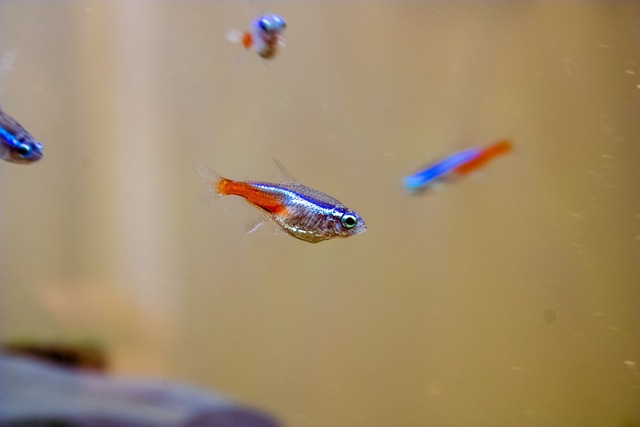
Neon Tetra
Scientific name: Paracheirodon innesi
The Neon Tetra is a small, vibrant freshwater fish native to the blackwater and clearwater streams of the Amazon Basin in South America.
Renowned for its striking iridescent blue and red stripes, the Neon Tetra adds a splash of color to any aquarium. They are peaceful and social fish that thrive in groups, making them an ideal choice for community tanks.
Their hardy nature and easy-going temperament make them suitable for both beginner and experienced aquarists.
IUCN Red List of Threatened Species : Least Concern
Neon Tetras are schooling fish that should be kept in groups of at least six, although larger groups are preferable for them to display natural behaviors. They are active swimmers that occupy the middle and upper levels of the aquarium. Providing them with a well-planted tank with open spaces for swimming enhances their environment.
They are omnivorous and enjoy a varied diet of high-quality flake food, micro-pellets, and live or frozen foods like brine shrimp or daphnia. Their peaceful nature makes them compatible with a wide variety of tank mates, including other small, non-aggressive fish.

Navite Location
South America (Brazil, Colombia, Peru)
Varieties
Standard / Long-Finned / Gold Neon / Diamond Head
Suggested Tank Mates
Other Tetras (Cardinal Tetras, Black Neon Tetras) / Guppies / Mollies / Platies / Corydoras Catfish / Harlequin Rasboras
Tank Mates to Avoid
Large or aggressive fish / Large Cichlids / Bettas / Arowanas / Any fish large enough to eat them
Diet
High-quality flake food / Micro-pellets / Live or frozen foods / nsect-based foods
Breeding
Neon Tetras breed by scattering eggs in soft, acidic water under subdued lighting. Breeding can be challenging due to their sensitivity to water conditions and light.
Lifespan
5 to 8 years with proper care
Size
Up to 4 cm (1.5 inches)
Minimum Tank Size
10 gallons (38 liters) for a small school
Optimum Tank Temperature
21°C to 27°C (70°F to 80°F)
Ideal pH Level
5.5 to 7.0
Water Hardness
1 – 10 dGH
Common Health Issues
Neon Tetra Disease / Ich (White Spot Disease) / Fin Rot / Fungal Infections / Internal Parasites
Interesting facts
They Reflect Light
Neon Tetras have iridescent scales that reflect light, making them highly visible in the dark, tannin-stained waters of their natural habitat. This reflection helps them stay together in schools and avoid predators.
First Discovered in the 1930s
Neon Tetras were first imported into the aquarium trade in the 1930s and quickly became popular due to their bright colors and peaceful nature.
Sensitive to Light During Breeding
The eggs and fry of Neon Tetras are extremely sensitive to light. In the wild, they breed in dark conditions, and excessive light can be harmful to their development.
They Communicate Through Color Changes
Neon Tetras can adjust the intensity of their coloration based on mood, health, and environmental conditions, which can be a form of communication among them.
Large Schools in the Wild
In their natural habitat, Neon Tetras can form schools numbering in the hundreds, providing safety in numbers from predators.
Variety in the Genus
Neon Tetras are closely related to Cardinal Tetras and Green Neon Tetras, which are similar in appearance but have slight differences in coloration and size.
Neon Tetra FAQ’s
Are Neon Tetras Livebearers?
No, Neon Tetras are not livebearers; they are egg layers. Specifically, they are known as egg scatterers. During spawning, the female releases eggs randomly throughout the aquarium, and the male fertilizes them externally. The eggs are adhesive and typically settle on plants, substrate, or any available surface. Neon Tetras do not exhibit parental care—in fact, they may consume their own eggs or fry if given the chance.
Can Neon Tetras Regrow Their Fins?
Yes, Neon Tetras can regrow their fins if they have been damaged or torn, provided they are given proper care and the underlying cause of the fin damage is addressed.
Fin regeneration is a natural process in many fish species, including Neon Tetras. The regrowth depends on several factors such as the extent of the damage, water quality, nutrition, and overall health of the fish.
Do Neon Tetras eat off the bottom?
Neon Tetras are mid-level swimmers that primarily feed in the middle and upper layers of the aquarium. They prefer to eat food that is floating or suspended in the water column, such as flake food, micro-pellets, or tiny live and frozen foods like brine shrimp and daphnia.
While they may occasionally pick at food particles that have sunk to the bottom, they are not natural bottom feeders and do not typically eat off the substrate.
Do Neon Tetras need a special substrate?
Neon Tetras do not require a special substrate for their well-being. However, using a dark-colored substrate can enhance their vibrant red and blue colors, making them stand out more in the aquarium.
How Can You Tell if a Neon Tetra Is Male or Female?
Distinguishing between male and female Neon Tetras can be subtle but possible with careful observation:
- Body Shape – Females generally have a rounder and fuller body, especially when carrying eggs. Males are slimmer and more streamlined.
- Blue Stripe – The iridescent blue stripe along the side of the female may appear slightly bent or curved due to their fuller bodies. In males, this stripe is usually straight.
- Size – Females may be slightly larger than males, though the difference is minimal and can be hard to notice.
Keep in mind that these differences are not always pronounced, and accurately sexing Neon Tetras may require experience.
How Long Do Neon Tetras Live?
Neon Tetras typically have a lifespan of 5 to 8 years in a well-maintained home aquarium.
With optimal care, some Neon Tetras may live up to 10 years, although this is less common. Their longevity is influenced by several factors, including water quality, diet, stress levels, and overall tank conditions.
How many Neon Tetras should be kept together?
Neon Tetras are schooling fish that thrive in groups. It is recommended to keep them in groups of at least six, but larger schools of 10 or more are ideal.
Keeping them in a sizable group allows them to exhibit natural behaviors, reduces stress, and enhances their overall health. A larger school also creates a more dynamic and visually appealing display in your aquarium.
Ensure your tank is adequately sized to accommodate the number of fish, providing enough space for them to swim freely.
